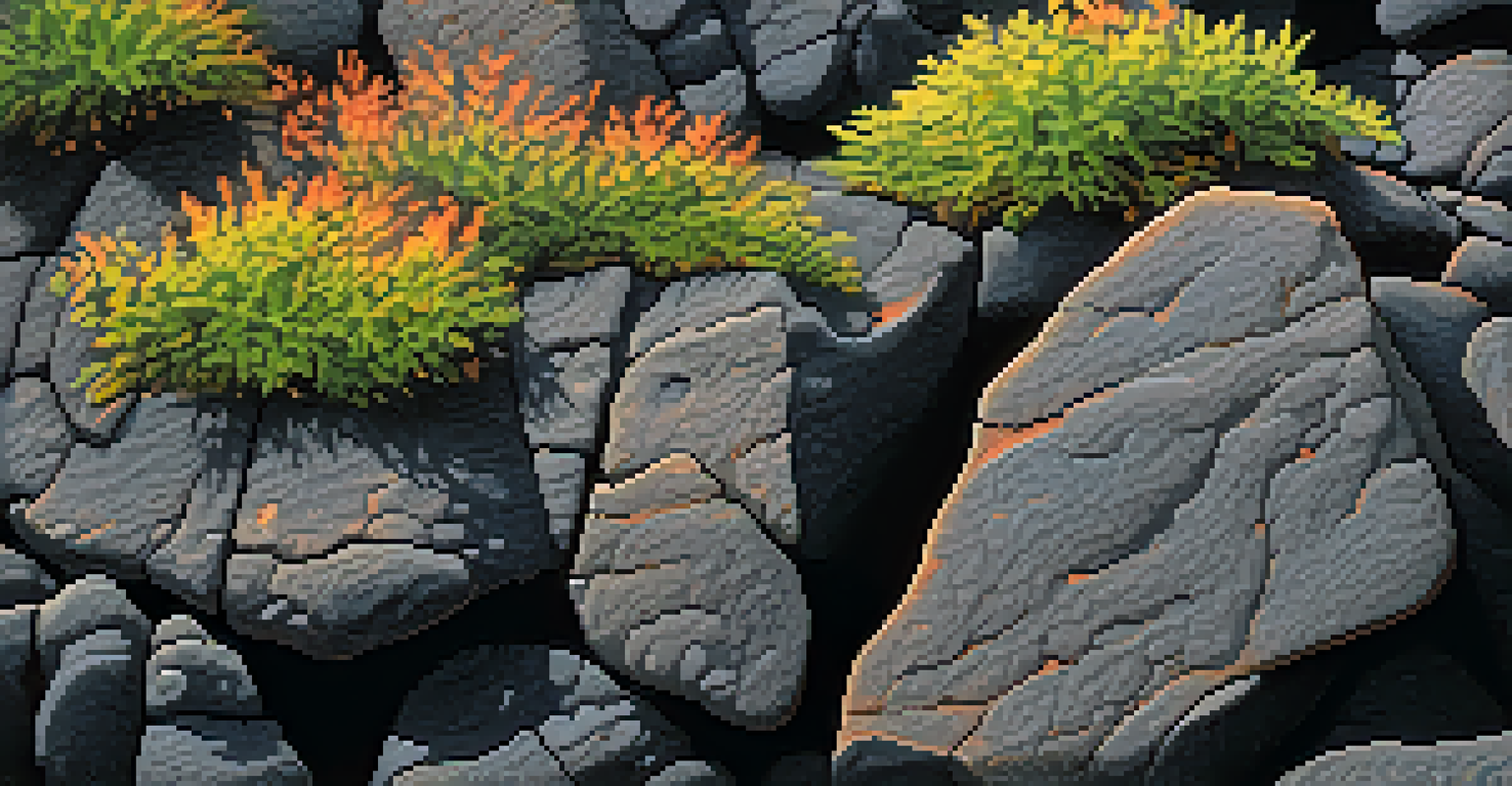The Role of Hot Spots in Hawaii's Geological Evolution

Understanding Geological Hot Spots and Their Significance
Geological hot spots are volcanic regions thought to form over mantle plumes, which are columns of hot magma rising from deep within the Earth's mantle. These hot spots create volcanic islands and can lead to significant geological changes over time. In the context of Hawaii, these hot spots play a pivotal role in the formation of the islands, contributing to their unique landscapes and ecosystems.
Volcanoes are the lungs of our planet. They are the source of life and the origin of our atmosphere.
Hawaii's hot spot is particularly fascinating because it is located in the middle of the Pacific Plate, which moves over this stationary plume of magma. As the plate shifts, new volcanoes emerge while older ones become dormant, leading to a chain of islands formed by volcanic activity. This movement allows scientists to study the geological history of the region through the ages.
Understanding these hot spots not only provides insight into Hawaii's past but also helps scientists predict volcanic activity and its potential impacts on the islands. By examining how these geological processes work, we can better appreciate the dynamic nature of our planet.
The Formation of the Hawaiian Islands: A Volcanic Journey
The Hawaiian Islands were formed through a series of volcanic eruptions over millions of years, resulting from the Pacific Plate moving over a hot spot. The oldest island, Kauai, is believed to be around 5 million years old, while the youngest, the Big Island of Hawaii, is still growing today. This ongoing process showcases the remarkable power of geological forces at work.

As the Pacific Plate continues to shift northwestward, new volcanoes emerge, creating new land. The Big Island is home to Mauna Loa and Kilauea, two of the world's most active volcanoes, continuously reshaping the landscape. This volcanic activity not only builds the islands but also influences the surrounding marine ecosystems.
Hawaii's Islands Form Through Volcanoes
The Hawaiian Islands are created by volcanic eruptions resulting from the Pacific Plate moving over a stationary hot spot.
Hawaii's geological evolution is not just about the islands' formation; it also includes the erosion and weathering processes that shape their current appearance. As the islands age, they experience a variety of environmental factors that further sculpt their landscapes, demonstrating the ongoing interplay of creation and destruction in nature.
The Impact of Plate Tectonics on Hawaiian Geology
Plate tectonics is the theory explaining the movement of Earth's lithosphere, which is divided into several large plates, including the Pacific Plate. This movement is responsible for the formation of various geological features around the world, and in Hawaii, it directly influences the islands' growth and evolution. As the Pacific Plate slides over the hot spot, it creates a trail of volcanic islands.
The earth does not belong to us, we belong to the earth.
This tectonic activity also leads to phenomena such as earthquakes and tsunamis, which can have significant effects on the islands' geology and human activity. For instance, the 2018 eruption of Kilauea dramatically altered the landscape, illustrating how interconnected these geological processes are. Understanding these movements is crucial for predicting future volcanic events and safeguarding local communities.
The relationship between plate tectonics and hot spots highlights the intricate dance of geological forces that shape our planet. By studying these interactions, scientists can gain a deeper understanding of not only Hawaii's geology but also the broader dynamics of Earth's surface.
Volcanic Activity: The Heart of Hawaii's Ecosystem
Volcanic activity is not just a geological phenomenon; it is a vital component of Hawaii's ecosystem. The rich, volcanic soil created by the decomposition of lava supports a diverse range of plant life, which in turn sustains a variety of animal species. This unique environment is a testament to the resilience and adaptability of life in extreme conditions.
Additionally, the continuous eruptions contribute to the formation of new habitats, allowing different species to thrive in varying ecosystems. For example, the lava flows create new land for plants to colonize, which attracts birds and other wildlife. This dynamic interplay between volcanic activity and ecological development highlights the importance of understanding geological processes.
Cultural Ties to Volcanic Activity
In Hawaiian culture, volcanoes are sacred and symbolize the spirit of the islands, as embodied by the goddess Pele.
Moreover, volcanic eruptions also impact the local climate and air quality. While the ash and gases released can have negative effects, they also play a role in nutrient cycling within the ecosystem. This complex relationship illustrates how interconnected geology and ecology truly are in Hawaii.
Cultural Significance of Volcanoes in Hawaiian Society
In Hawaiian culture, volcanoes hold great significance, often viewed as sacred entities. The goddess Pele, known as the goddess of fire and volcanoes, represents the spirit of the islands and embodies the fierce power of nature. This deep respect for volcanic activity is woven into the fabric of Hawaiian traditions and stories.
The cultural importance of volcanoes is evident in local practices and celebrations that honor the land and its geological features. Communities often engage in rituals and festivals that pay tribute to Pele, recognizing her role in shaping the islands and providing a sense of identity for the people. This connection to the land fosters a sense of stewardship and responsibility toward preserving the environment.
Understanding the cultural significance of volcanoes not only enriches our appreciation of Hawaii's heritage but also underscores the importance of balancing geological study with respect for local beliefs. By bridging science and culture, we can gain a holistic understanding of Hawaii's unique identity.
Challenges of Living on a Volcanic Island
Living on a volcanic island like Hawaii comes with its share of challenges. The constant threat of volcanic eruptions, earthquakes, and lava flows can create uncertainty for residents and impact daily life. For instance, the 2018 Kilauea eruption displaced many families and altered the landscape dramatically, showcasing the raw power of nature.
In addition to immediate dangers, there are long-term considerations such as air quality and land use. Volcanic gases can affect respiratory health, while lava flows can destroy homes and infrastructure. Preparing for these challenges requires a proactive approach, including emergency planning and community awareness to ensure safety and resilience.
Challenges of Volcanic Living
Residing on a volcanic island like Hawaii presents challenges such as eruptions and air quality issues, requiring community resilience.
Despite these challenges, many residents embrace the beauty and uniqueness of their volcanic home. The sense of community and shared experiences often foster a strong bond among locals, reinforcing their commitment to supporting one another in times of need. This resilience exemplifies the spirit of Hawaii and its people.
Future of Hawaii's Geology: Hot Spots and Climate Change
As we look to the future, the interplay between hot spots and climate change presents intriguing possibilities for Hawaii's geological evolution. While hot spots will continue to shape the islands over time, climate change poses new challenges that could impact volcanic activity and sea levels. Understanding these factors is essential for predicting how Hawaii may evolve in the coming decades.
For instance, rising sea levels threaten coastal communities and ecosystems, potentially altering the landscape dramatically. Additionally, changes in temperature and precipitation patterns can affect the delicate balance of life on the islands. These environmental shifts may interact with volcanic activity, leading to unforeseen consequences for both geology and ecology.

To navigate these challenges, ongoing research and collaboration among scientists, policymakers, and local communities are crucial. By prioritizing sustainability and resilience, Hawaii can continue to thrive while honoring its rich geological heritage.